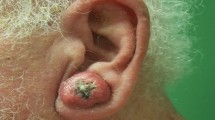Abstract
An 82-year-old male presented with numerous pruritic erythematous nodules over his trunk and extremities. Histopathology was consistent with keratoacanthomas. Given the extent of his disease, medical therapy was recommended. Based on phosphorylated epidermal growth factor receptor expression in lesional keratinocytes, treatment with erlotinib 150 mg daily was initiated, with rapid improvement in the number and appearance of nodules. Immunohistochemistry following treatment revealed a decrease in lesional pEGFR expression, consistent with inhibition of this receptor activation. This is the first report of multiple keratoacanthomas responding to therapy with an EGFR tyrosine kinase inhibitor, and it supports an emerging role for the use of EGFR inhibitors in the management of cutaneous malignancies.
Similar content being viewed by others
Avoid common mistakes on your manuscript.
Introduction
Keratoacanthomas are tumors of variable biologic behavior that occur in both solitary and multiple forms. Multiple lesions often require systemic treatment, although no standard regimen exists.
Case report
An 82 year-old otherwise healthy male presented with numerous pruritic red nodules over his chest, back, legs, and arms. Physical examination demonstrated multiple skin-colored to erythematous papules and nodules, with central keratotic plugging and overlying scale (Fig. 1) and pitting edema of his lower extremities. Histopathology revealed epithelial hyperplasia with craterlike formation and broad lobules of keratinocytes infiltrating the dermis, with abundant glossy cytoplasm and minimal cytological atypia (4×, Fig. 2) consistent with keratoacanthomas. Evaluation for internal malignancies had been negative, and he had no history of HIV or other syndromes associated with immunodeficiency. Given the extent of his disease, medical therapy was recommended. The patient declined therapy with the retinoid acitretin, anecdotally reported to be effective in this setting [1], due to concern about adverse effects. Based on phosphorylated epidermal growth factor receptor (pEGFR) expression in lesional keratinocytes (Fig. 3), treatment with erlotinib 150 mg daily was initiated, with rapid improvement in the number and appearance of nodules (Fig. 4). Immunohistochemistry of day 21 post-treatment lesions revealed a decrease in pEGFR expression (Fig. 5) consistent with inhibition of this receptor activation.
Discussion
Keratoacanthomas are rapidly growing cutaneous tumors of variable biologic behavior. Four types––solitary, multiple, eruptive, and keratoacanthoma centrifugum marginatum––have been described. In the eruptive type, there is a rapid, diffuse development of dome-shaped papules with a keratatotic center [1–3]. Lesions may number in the tens or hundreds, and are often intensely pruritic. While lesions may spontaneously involute over a period of 4–6 months, they can cause significant tissue destruction leading to morbidity. Although the etiology is unknown, sun exposure, human papilloma virus (HPV), and chemical carcinogens have been identified as possible causative factors [4, 5]. Other proposed associations include internal malignancies, immunodeficiency, and dysregulation in tumor suppressor genes (p53) and DNA mismatch repair genes, as occurs in Muir–Torre syndrome, in which keratoacanthomas and sebaceous tumors arise in association with malignancies of the colon, breast and genitourinary tract.
Effective therapies for solitary keratoacanthomas include surgical excision, cryotherapy, radiotherapy, and intralesional injections of 5-FU, bleomycin, and methotrexate [6–9]. Treatment of multiple keratoacanthomas is more problematic, as the number of lesions makes surgical or destructive techniques impractical, and recurrence is frequent [10]. We hypothesized that keratoacanthomas would exhibit increased activation of EGFR, making them a target for therapy with an EGFR tyrosine kinase inhibitor. In this patient, erlotinib rapidly reduced the number, size, and symptoms associated with multiple keratoacanthomas. Additionally, there was a reduction in pEGFR in post-treatment lesional biopsies. To our knowledge, this is the first report of multiple keratoacanthomas responding to therapy with an EGFR tyrosine kinase inhibitor. This case supports an emerging role for the use of EGFR inhibitors in the management of cutaneous malignancies.
References
Wee SA (2004) Multiple eruptive keratoacanthomas, de novo. Dermatol Online J 10:19
Chu DH, Hale EK, Robins P (2003) Generalized eruptive keratoacanthoma of Grzybowski. J Drugs Dermatol 2:318–319
Consigli JE, González ME, Morsino R et al (2000) Generalized eruptive keratoacanthoma (Gryzbowski variant). Br J Dermatol 142:800–803
Hsi ED, Svoboda-Newman SM, Stern RA (1997) Detection of human papillomavirus DNA in keratoacanthomas by polymerase chain reaction. Am J Dermatopathol 19:10–15
Forslund O, DeAngelis PM, Beigi M (2003) Identification of human papillomavirus in keratoacanthomas. J Cutan Pathol 30:423–429
Donahue B, Cooper JS, Rush S (1990) Treatment of aggressive keratoacanthomas by radiotherapy. J Am Acad Dermatol 23:489–493
Leonard AL, Hanke CW (2006) Treatment of giant keratoacanthoma with intralesional 5-fluorouracil. J Drugs Dermatol 5:454–456
Sayama S, Tagami H (1983) Treatment of keratoacanthoma with intralesional bleomycin. Br J Dermatol 109:449–452
Cuesta-Romero C, de Grado-Peña J (1998) Intralesional methotrexate in solitary keratoacanthoma. Arch Dermatol 134:513
Feldman RJ, Maize JC (2007) Multiple keratoacanthomas in a young woman: report of a case emphasizing medical management and a review of the spectrum of multiple keratoacanthomas. Int J Dermatol 46:77–79
Conflict of interest statement
Mario Lacouture received honoraria from Onyx Pharma, ImClone Systems, Amgen Inc., and Bayer Pharmaceuticals.
Author information
Authors and Affiliations
Corresponding author
About this article
Cite this article
Reid, D.C., Guitart, J., Agulnik, M. et al. Treatment of multiple keratoacanthomas with erlotinib. Int J Clin Oncol 15, 413–415 (2010). https://doi.org/10.1007/s10147-010-0047-8
Received:
Accepted:
Published:
Issue Date:
DOI: https://doi.org/10.1007/s10147-010-0047-8









